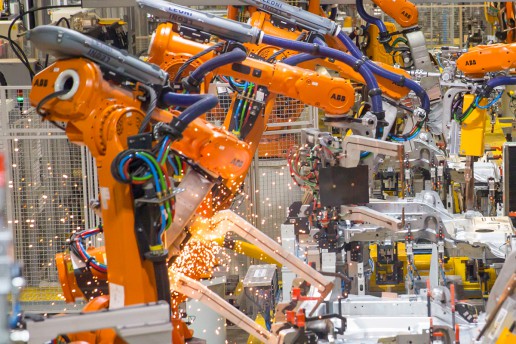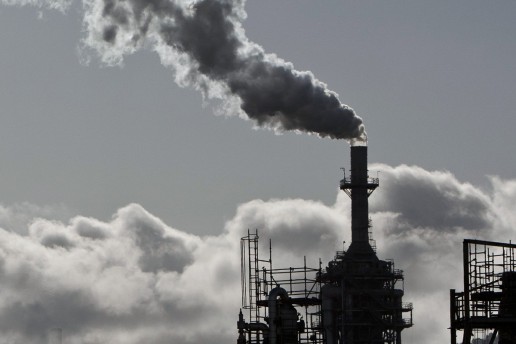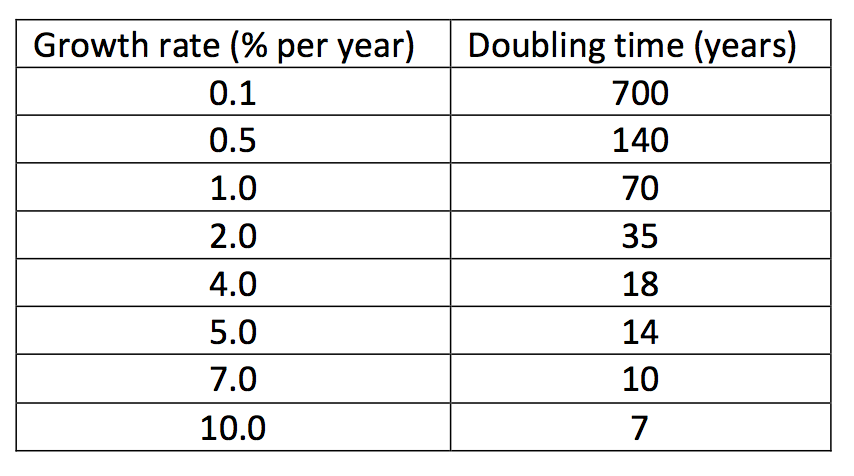The growth dilemma
Emil Urhammer & Inge Røpke
Despite various criticisms, it is clear that economic growth, measured as GDP growth, is still the key objective of economic policy. However, since the financial crisis in 2008, it has become more common to talk about being on the brink of a systemic crisis in which economic and environmental crises occur simultaneously and are interwoven together in a variety of complex ways. The ecological economist, Tim Jackson, has said that we are in a dilemma - the growth dilemma - where economic growth, on the one hand, is undermining the environment through climate change and ecosystem destruction, while growth, on the other hand, is necessary to maintain prosperity, employment and the financing of the welfare state, due to the way our economic system is organised today.
https://www.youtube.com/watch?v=JRvk9Nl31X4
In this video, you can listen to Tim Jackson talking about the growth dilemma
Decoupling
In order to overcome the dilemma of growth, growth supporters often put their faith in decoupling, which suggests that with the help of technological innovations and resource efficiency, it will be possible to disconnect economic growth from the environmental impact. However, in a critical analysis of the idea of decoupling, Tim Jackson argues that it is an unrealistic hope.
In order to understand Jackson’s arguments, it is necessary to distinguish between two different types of decoupling: relative and absolute. Relative decoupling means that the environmental impact per unit of economic output decreases. This does not mean that the environmental impact in itself is falling, but that GDP has increased more than the environmental impact. In contrast to relative decoupling, absolute decoupling means that the environmental impact has fallen in absolute terms, although GDP has increased.
[otw_shortcode_info_box border_type="bordered" border_style="bordered"]The IPAT equation
The IPAT equation describes the relationship between, on the one hand, environmental impact and, on the other hand, population size, affluence and a technology factor, which denotes the environmental impact per unit of GDP. IPAT can be seen as a tool for understanding and discussing relationships between environmental impact, population size, affluence and technological ability.
The equation itself is as follows:
I = P × A × T (Impact = Population × Affluence × Technology).
Where I is the environmental impact (measured in different units depending on the environmental problem being investigated), P is population, A is affluence (measured in GDP per person) and T is a technology factor (measured in environmental impact per unit of GDP).
An example of the use of the equation could be to look at global CO2 emissions. In this case, I denotes global CO2 emissions given by:
CO2 (gigatons) = P (population) × A (GDP/population) × T (gigatons/GDP).
Where population is the total population of the planet, and GDP is the global GDP.
The equation can be used for several different problems, where I will often denote pollution or resource consumption.[/otw_shortcode_info_box]
The IPAT equation (see the infobox above) can be used to get a better sense of the difference between relative and absolute decoupling. If T, i.e. the environmental impact per. unit of GDP, becomes smaller, relative decoupling has occurred, while absolute decoupling has occurred when I becomes smaller. As a rule of thumb, one can say that absolute decoupling in a world where both the population and GDP per inhabitant is increasing can only be achieved if relative decoupling compensates for the effect of population and income growth. When adopting a global perspective, it is difficult to find any historical examples of something like this occurring.
To illustrate this, Jackson uses the IPAT equation to analyse global CO2 emissions, which means that I denotes global CO2 emissions, and T denotes CO2 intensity. CO2 intensity means CO2 emissions per unit of GDP. High intensity means that a large amount of CO2 per GDP unit has been emitted, while low intensity means the opposite. High CO2 intensity is, thus, the same as low CO2 efficiency.
Jackson points out that CO2 intensity has fallen by, on average, 0.7% per annum since 1990. However, this has been counteracted by an average population growth rate of 1.3% per year and an average income increase of 1.4% per year, which means that the efficiency improvements have not offset the effects of a growing world population. Instead, total CO2 emissions rose on average by 2% per year from 1990 to 2007.
Similarly, Jackson also examines the potential for absolute CO2 decoupling in the future. He concludes that with the official projections for the world population and income per person, the improvement necessary for T is of an order of magnitude that must be considered virtually impossible – in any case it has never been seen previously in history. In addition, including the idea of greater equality in income at the global level makes the challenge even more enormous. For example, if all people in the world are to have the same level of income as those living in Europe, by 2050, the world economy will have to be six times larger than it is now. If we are to stay within the IPCC’s limits for CO2 in the atmosphere, CO2 intensity will have to decrease by about 9% per year until 2050.
With a 0.7% drop in intensity per year, which we have seen since 1990, we can conclude that the challenge for efficiency improvements is quite significant. In response to this problem, Jackson suggests that we begin to consider whether continual economic growth is appropriate instead of hoping that technology will bring about the necessary improvements in efficiency. With regards to the IPAT equation, this means that Jackson suggests that we should begin to reduce A and P so that T is not the only factor that can reduce I, thus creating absolute decoupling.
Rebound effects
When dealing with the opportunities for decoupling economic growth from consumption of energy and resources, another challenge arises called rebound effects, which refers to the problem where energy or resource efficiency improvements often lead to additional consumption, which offsets the effect of the efficiency improvements. To take car use as an example: If you replace your old car with a newer, more energy-efficient model that can drive further per litre, what often happens is that the economic savings gained as a result of the increased efficiency are transformed into increased use of the car. In this way, efficiency improvements result in more driving instead of energy savings. This mechanism is also known from house insulation, where improved insulation can lead to higher room temperatures instead of decreasing energy consumption. Finally, rebound effects are also seen in connection with increased consumption due to the economic savings achieved by energy or resource efficiency improvements. To take the example of the car again: If you do not in fact start to drive more or further having purchased a new energy-saving car, you will save money. However, if this saving is then converted into additional consumption because, for example, you buy a new mobile phone, then a rebound effect in the form of an environmental impact will have arisen.
Green growth
An earlier section discussed how growth supporters put their faith in decoupling economic growth and environmental damage to solve the growth dilemma. This approach is often referred to as green growth and can be considered a political programme for solving the many economic and environmental crises of our time. In green growth, there is a particular focus on resource efficiency, investment in renewable energy and green innovation. With this focus, green growth is strongly linked to market-oriented solutions, which is also reflected in the idea of using price-regulating interventions, such as resource and environmental taxation, to change economic behaviour, increase resource efficiency and reduce the environmental impact. Furthermore, among some supporters of green growth, a desire to find a new measure for economic growth has also been expressed. The idea often involves supplementing or correcting GDP by means of other indicators that measure environmental and social effects which are not included in GDP.
Degrowth
In line with Tim Jackson’s scepticism about the possibility of decoupling, an international movement called degrowth has emerged since the financial crisis of 2008. Degrowth supporters argue that economic growth has reached its environmental limits and that it is, therefore, high time that a transition was made to a new economy, which is not based on economic growth. Degrowth is an extensive political programme that addresses many different aspects of the economy, where the solution to the growth dilemma involves transitioning to a non-growth economy that focuses on fair distribution of the resources of the Earth and global society. This does not mean that supporters of degrowth are against resource efficiency and innovation; it just means that they think much more is necessary to solve the growth dilemma. In a global economy that is characterised by resource and environmental constraints, it is also necessary that the limited resources are shared fairly between individuals and nations. In this way, the idea of equality is central to the degrowth movement.
In contrast to green growth, degrowth is a political programme that requires a radical break with the predominant economic logic of economic growth, public cutbacks and increased labour supply. Instead, it involves slowing growth, the fair distribution of income and resources, reducing working hours, and maximum and minimum limits for income, and the opportunity for an unconditional basic income for all.
Another important theme for the degrowth movement is the influence of large companies and super rich individuals on the economy and democracy. This influence is manifested in, amongst others, environmental conflicts where multinational companies attempt to take control and exploit natural resources such as drinking water, oil and fish stocks at the expense of local populations who have lived for centuries in the areas where these resources are present. Therefore, part of the degrowth movement’s intention is also to draw attention to these conflicts and to problematise the abuse of the rights of marginalised populations. In this way, degrowth also involves fighting against multinational companies and extremely wealthy individuals’ control of natural resources and their influence on politics.
A final point in relation to degrowth also needs to be mentioned, and that is that the financial sector is seen as a significant societal problem and as a central cause of economic instability and inequality. Therefore, for supporters of degrowth it is important that radical steps are taken to control the financial sector through comprehensive regulation, the breaking up of banks that have become too large, and greater government involvement in the financial sector’s activities in general. In this way, the financial sector will help the economy instead of being a sector that primarily focuses on how to make a profit from complicated financial transactions.
Growth agnosticisim
Closely related to the degrowth idea is the concept of growth agnosticism, which assumes that economic growth is just not the key socioeconomic problem of our time. For growth agnostics, there is no need to spend so much time discussing whether it is good or bad that GDP goes up or down or what a new measure of growth should look like as there are more important problems, such as climate change, unemployment and inequality, to solve. In this light, discussions and efforts to achieve economic growth are considered an unnecessary obstacle to solving society’s most urgent problems.
Production result - the ’real cake’
Inge Røpke
According to ecological economics, there is no doubt that there are limits to growth in biophysical terms. But does this also mean that there are limits to growth in economic terms? This depends, of course, on what you really mean by ‘economic growth’. Before we turn to the definition of economic growth that is connected to the concept of GDP, there follows some more fundamental considerations of what is available to society. A fundamental problem in economic theory is whether one can define what a society has available for consumption and investment during the course of one year. Can you say that in one year, society produces a ‘real cake’ - a production result, some of which is reserved for investment, while some is shared between the members of society for consumption? And can the ‘cake’ be measured?
For ecological economics, it would be natural to look at society’s energy surplus as a measure of the size of the cake. When people live in a society that has access to much more energy than the amount needed for survival (the endosomatic energy consumption multiplied by the population size), the members of society have the opportunity to achieve a high standard of living. Although this makes sense, it is not very satisfactory to measure the size of the production result in direct proportion to the size of the input. The potential for a high standard of living is not the same as achieving it. A lot of energy may be available to a society without it being transformed into something of great value for them. Firstly, part of the energy may be lost in the form of waste in the process, and secondly, production may consist of products that are not useful to the society. Therefore, it would be more satisfactory if the production result could be considered in a way that reflects the use value.
Producing and consuming the cake
When the output result can not be measured in a meaningful way from the input side, can it be done from the output side? Here the key question is what the production result actually consists of: What should be included in the ‘real cake’ that has resulted from the year’s efforts and what should be considered as consumption of the cake? Throughout the history of economic theory, what should be considered part of the production result and, thus, what human activities should be considered productive activities and which consumption activities, respectively, has been a controversial question. It is fairly easy to agree that the production of food, clothing and housing are productive activities that contribute positively to the production result. In the past, it was common to regard only the procurement of the necessities for life as productive because they form the basis for everything else: only once the productive are able to procure more necessities for life than they can use themselves, can society afford for others to spend their time caring for the elderly and the sick, holding concerts and practising religious rituals. However, if the perspective is to be meaningful, the range of productive activities quickly becomes wide because many activities are prerequisites for the direct production of the necessities for life, such as the production of the tools to be used and the care and education activities that are needed to ensure that a new labour force grows up and obtains the necessary qualifications. The more complex societies become, the wider the range of activities that come to play a more or less central role in the basis of life: The necessities of life not only have to be produced, but also distributed, while the waste must be disposed of, etc. Just like in an ants’ nest or an ecosystem, the many different functions are interdependent. In addition, it becomes increasingly difficult to define what the most basic necessities for life are. It does not really make sense to identify ever larger homes and increasingly varied food and clothing necessities for life if care for the elderly and sick, holding concerts, etc. are not.
When it is so difficult to define productive activities in a meaningful way, it is natural to choose the opposite extremity, i.e. that all activities are productive and contribute to the production result. However, this does not seem very satisfactory either. Firstly, it is common to distinguish between production and consumption, where productive work is seen as a prerequisite for consumption activities: Food must first be produced before it can be eaten. Although nutrition is a prerequisite for production, it is nevertheless common to consider dining as a kind of purpose of the productive activities and, hence, a consumption activity. In the literature on time studies, there is a proposal for a general criterion for how to distinguish between production and consumption: An activity should be considered consumption if it can only be performed by the active person - or if its value decreases as a result of being transferred to others. As Erik Ib Schmidt writes, “You can not let others eat and drink for you, or let them sleep, go for a walk, play football or read a good book for you, and you can not leave it to someone else to listen to good music for you or love for you.” (translated from “Behøver vi nå det hele?” Spektrum 1990). At the same time, it is acknowledged that the criterion involves borderline cases. For example, education is inextricably linked to the person who takes the education, which means the criterion suggests that education should be defined as consumption, even though, at the same time, it can have the character of a productive investment. In order to produce measurements and statistics, borderline cases must be addressed, but this is not essential for more fundamental considerations.
Another reason not to consider all activities as productive is based on the view that some activities do not increase the production result, but rather involve waste or are directly harmful. For example, some will doubt the usefulness of trying to persuade people (for example, through advertising) to use something that they can easily do without; or the useful in producing something that is harmful to health (such as tobacco) or increases the risk of war (such as weapons). In addition, it is important to take into account the fact that many useful activities can also have harmful effects in the form of, for example, pollution. This suggests that the production result should be applied as net term from which the harmful effects are deducted.
Thirdly, some activities involve redistribution rather than production. For example, many would doubt that there is anything productive about an activity such as stealing, even though Robin Hood may have increased the overall quality of life by taking from the rich and giving to the poor. In many societies, the production result is redistributed to take care of, for example, the elderly and sick, who can not contribute to the production of the goods themselves. However, redistribution is not considered production. As discussed in the section on distribution, societies also have mechanisms that secure strong groups a share of the production result at the expense of others.
These arguments suggest that it makes sense to distinguish between productive and non-productive activities, even in complex societies: Even though everything is connected, it seems obvious to distinguish between production and consumption. In addition, it is common to distinguish between activities that contribute to the production of use values and those that redistribute the use values. However, at the same time, the specific dividing lines are controversial. From an ecological economics perspective, some of the frequently applied criteria do not make sense. For example, productive and unproductive activities can not be distinguished based on a criterion that is based on the economic entity that performed the activity: An activity does not become more or less productive because it is performed by a private enterprise instead of a household or the public sector. It does not matter if vegetables are grown in a horticultural business or in a private garden, or if children are taken care of in a public nursery, by a privately-employed au pair or by the parents; it is still a contribution to the production result. Furthermore, whether someone earns money by performing a task is not a relevant criterion. One can say that payment is a kind of proof that someone perceives something as useful, but a lack of payment does not necessarily indicate the opposite. Whether money is earned or not has something to do with the distributive mechanisms, which is discussed in the section on distribution.
The size of the cake and its use
When the production result is seen as a ‘real cake’ - a quantity of use values that are available to a society in a given year - it makes most sense to refer to the final cake so that raw materials and intermediates are not included in the calculation several times. In the course of the year, some use values are used to produce other use values. Since they have only been a means to an end, they should not be included in the real cake: In other words, the real cake is the final baked cake - not the flour, the eggs and the sugar that are used to make it. Some of the use values in the final real cake are set aside to be used to increase future production. Such investments include, for example, new buildings, machinery, education and research activities as well as nature restoration (consumer goods that are stored for later can also be considered investments). Other use values consist of goods and services such as food, clothing, housing use, theatre visits, childcare and health services that can be seen as consumption. What should be defined as consumption and investment can be discussed, but this delimitation is not crucial here (it is, however, when producing statistics and models). In the section on dynamics and distribution, we look at why the cake grows over time and how it is shared among social groups.
Although what has been presented here is in line with the idea that, in the course of a year, a society provides a production result, it must be noted that no suggestion has been made for how this amount of use values can be measured in a meaningful manner on the output side. Ecological economics has a suggestion for the biophysical measurements of the inputs used in production, but not for the measurement of output: There is no relevant common biophysical quality of output that makes it possible to combine the use values together. Nevertheless, the concept of the real cake will be used as an abstract idea of a quantity of use values in other sections.
Gross domestic product
In order to be able to combine the values together, they must have a shared feature. As the market economy develops, an increasing number of goods and services are traded on markets, and it becomes obvious to use prices as the common measure. Then the total sum of the year’s production of use values can be calculated by multiplying each individual item (or service) by its price and then combining them all together. In order to avoid double accounting, i.e. raw materials and intermediates being counted several times - the value of the inputs used from other producers must be deducted from the price of the individual product. In this way, the market value of the final baked cake can be calculated. It is this thinking that was embodied in the concept of Gross Domestic Product, GDP, in the 1930s. In the following, we focus on GDP without discussing why ecological economists are sceptical about the use of prices as a measure. We address this issue in the themes Driving forces and distribution and Political Decisions.
The idea behind GDP is derived from the simple cyclical model from neoclassical economics, where companies supply households with goods in return for payment on finished goods markets, while households supply companies with inputs to production in return for payment on the markets for production factors (based on the view that households ultimately are owners of all production factors). Based on this simple model (which excludes investments, the public sector and foreign countries), GDP can be calculated in three ways, which in principle give the same result. GDP is the annual sum of:
- The value added in all companies, i.e. the price of the goods minus the value of inputs from other companies (see above).
- The production value of all finished goods that are sold to the households (based on the price of the finished product without deducting inputs).
- The households’ income in the form of salary, dividends, interest, etc.
In practice, the calculations are, of course, more complicated, partly because investments, the public sector and foreign countries must also be included.
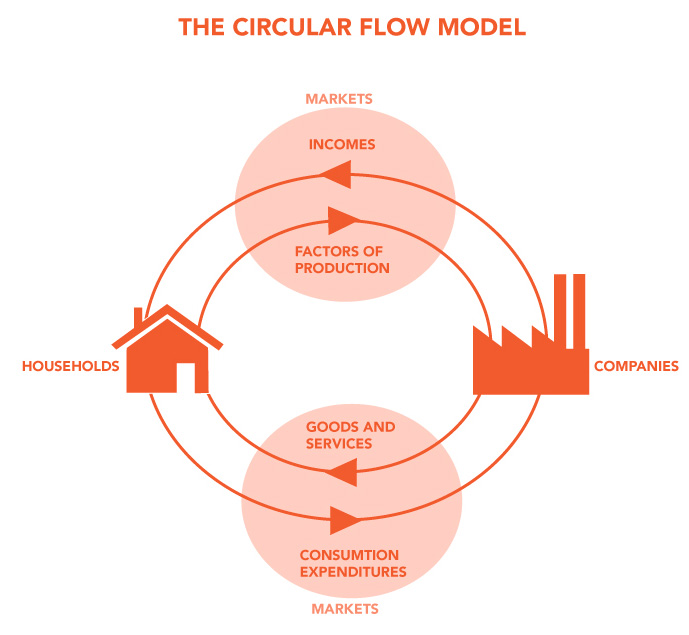
Attempts to develop statistical statements of society’s total production or income go back a long way, but it was not until around the time of the Great Depression in the 1930s that a serious focus was directed to managing the macro-economy and, hence, tools for measuring total economic activity. After the Wall Street Crash in 1929 and the subsequent explosion in unemployment, Western governments needed detailed statistics for the economy. In the United States, the economist, Simon Kuznets, was therefore given the task of creating a measure of the condition of the overall US economy, which led to one of the first proposals for what we today call Gross Domestic Product, GDP. Kuznets’s initial ambition was to create a measure of economic well-being, so he suggested, for example, deducting expenses for weapons, advertising and financial speculation from the national income. However, this focus changed crucially due to the preparation for war because it was important to calculate how many resources could be included in the war effort and because this effort should not appear to be a drain on the economy.
In this early phase of the development of the GDP measure, the accounts were a means to help tackle unemployment and mobilise resources for the war and it was not intended to be an end in itself. It was not until the 1950s and 1960s that GDP growth emerged on the agenda as a goal. This was, among other things, motivated by the competition with the Soviet Union. The Organisation for Economic Cooperation and Development (OECD) was one of the main driving forces behind making GDP a measure of economic growth and economic growth a top priority for economic policy.
Today, one does not have to follow the debate about the Danish economy closely to realise that economic growth is an indisputable central theme and one of the main objectives of economic policy. Economic growth is often perceived as being synonymous with prosperity, progress and surplus, while recession - the opposite of economic growth - is associated with poverty, regression and deficit. This status is due to, amongst others, the connection between economic growth and employment and the financing of the welfare state.
Criticism of GDP
While the GDP measure has become important in economic policy, criticism of the indicator has also grown. This criticism is becoming increasingly widespread, especially in connection with the emergence of global environmental problems.
The classic objections to GDP highlight the problems that Kuznets himself was concerned with. When all financial transactions are said to contribute to GDP, the result will not be a good measure of well-being. Firstly, GDP increases as a result of having to clean up after pollution and car accidents. Again, there is no deduction to GDP when economic activities reduce the stock of natural resources, such as oil, impoverish agricultural land or damage habitats for animals and plants. Secondly, there are many useful activities that are not included in GDP because they are not traded on a market. This applies to, for example, domestic work at home and voluntary work in associations. When more women entered the labour market in the 1960s, and more children were taken care of in child care centres, it resulted in an increase in GDP.
In addition, focusing on GDP as the central goal of welfare means that other aspects of welfare receive lower priority. For example, in recent years, there has been a lot of discussion about the importance of equality for the welfare of a society. On the basis of comprehensive statistical analyses, the social epidemiologists, Wilkinson and Pickett, have argued that more equal societies experience greater welfare, measured on a large number of parameters related to public health and crime. Similarly, others have pointed out that greater equality increases the degree of mutual trust and, thus, welfare in the society.
Many other criticisms of GDP have been expressed, while the actual calculation methods are changing continuously. For example, a controversial issue is how the financial sector’s contribution to GDP should be calculated (should the activities be considered productive or should the income of finance rather be seen as a deduction from the income of other sectors), while there is also a discussion about how statistics can capture what is happening in the digital economy, where many services are free.
Introduction: Growth and the environment
Economic growth is a central theme in economic thinking and it is usually presented as a social good - a necessity for social development. In this theme, we look at economic growth through a pair of ecological economics glasses. When we do this, several problems arise. Among other things, it becomes apparent that there are limits to growth in a biophysical sense, but there are also challenges regarding the way we measure economic growth. One can justifiably ask whether the measure of economic growth we currently use (GDP) is the right one at a time when the economy is changing and our world is being threatened by growing environmental crises. Finally, attention may also be paid to the fact that growth is a social dilemma because while on the one hand it is a successful recipe for welfare and stability, on the other hand, it involves significant environmental consequences.
Biophysical limits to growth
Emil Urhammer & Inge Røpke
One of the consequences of the biophysical perspective on the economy is the emphasis on limits to growth. In the biophysical perspective, the Earth is a system that primarily gets its energy from the sun, while the economy is seen as a metabolic organism that develops within the limits of the biosphere. The larger the organism - based on an ever-increasing flow of energy and materials - the greater the risk of the organism undermining its own conditions for life. The greatest risk is that the life-sustaining systems will be changed in ways that make the Earth less habitable for humans. The life-sustaining systems, for example, have an influence on the composition of the atmosphere, the water cycle, the nutrient cycle, the pollination of plants and soil fertility. Climate change is one of the many challenges that have arisen as a result of the fact that the economy’s metabolic organism has become too large. Many of the challenges are linked because, for example, attempts to restrict fossil fuel use lead to the increased use of biomass for energy purposes and, thus, to the overexploitation of agricultural land and water resources and pressure on biodiversity.
[otw_shortcode_info_box border_type="bordered" border_style="bordered"]Limits to Growth
In 1972, a group of young researchers at MIT in the United States published a groundbreaking study called ‘Limits to Growth’. In the study, a calculation model was used to prepare different global scenarios for the future. In the scenarios, an attempt was made to extrapolate the development of five global variables under different conditions. The five variables were: population, food production, industrial production, pollution and consumption of non-renewable resources. One of the scenarios was called the ‘standard run’, which was an estimate of how the five variables would change if the global economy continued on its current growth path. According to the model calculations, this would result in the collapse of the global economy in the middle of the 21st century if the course was not changed through political interventions. The group’s report was received with widespread scepticism and was met with great opposition from mainstream economists and politicians. The report was often seen as a prediction rather than as the warning it was intended to be. A subsequent study from 2008, which compares the original collapse scenario with the actual development since 1972, shows a clear connection between the scenario and the actual data, which suggests that the warning has unfortunately not been heard.[/otw_shortcode_info_box]
[otw_shortcode_info_box border_type="bordered" border_style="bordered"]Planetary boundaries
In 2009, a group of researchers led by the Swede, Johan Rockström, published a scientific study that has made a major contribution to the understanding of our present challenges and need for a sustainable transition. In the study, the group identifies nine so-called planetary boundaries, which must not be exceeded if the Earth is to remain a safe habitat for humans and other species. The boundaries were determined by investigating human- induced global changes of a magnitude that may be considered undesirable for the Earth’s life-sustaining systems. Climate change, biodiversity loss, acidification of the oceans, global consumption of fresh water and conversion of land to agriculture are some of the environmental problems for which the research team has defined planetary boundaries. By boundary is meant the point where the system transforms to a new state. With regards to climate change, the researchers determine the limit with the help of the amount of CO2 in the atmosphere and they estimate that this amount has already exceeded the critical limit at which point the climate system is about to transition to a new and much more unstable state. According to the researchers, several other planetary boundaries have also already been exceeded. This is true, for example, in the case of biodiversity as they believe that species loss is so advanced that it can have catastrophic consequences for the Earth’s ecosystems.[/otw_shortcode_info_box]
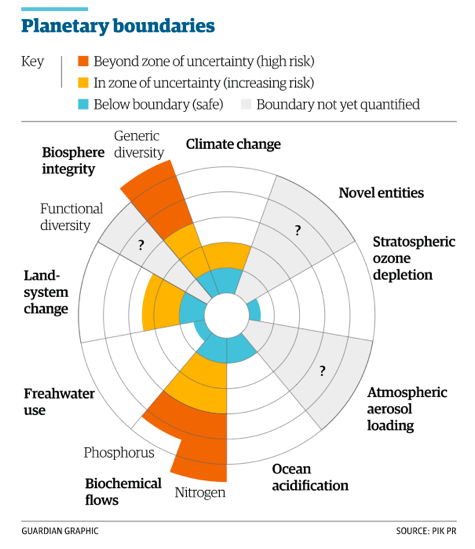
Exponential growth and doubling time
The two info-boxes above present two studies that highlight a mathematical phenomenon called exponential growth. In order to investigate the issue of growth and sustainability a little more, it is useful to focus on this phenomenon. This is because several of the processes that are currently threatening vital ecosystems and climatic balances are characterised by this kind of growth.
Most are familiar with so-called linear growth, where something grows by the same amount for each unit of time. For example, a child who grows eight centimetres a year, or a savings of pocket money that increases by 10 kroner each week. Exponential growth, on the other hand, is characterised by something that increases by a fixed percentage of the total amount for each unit of time. A population that increases by 1% of the total amount a year grows exponentially as does a savings with an interest rate of 5% per annum.
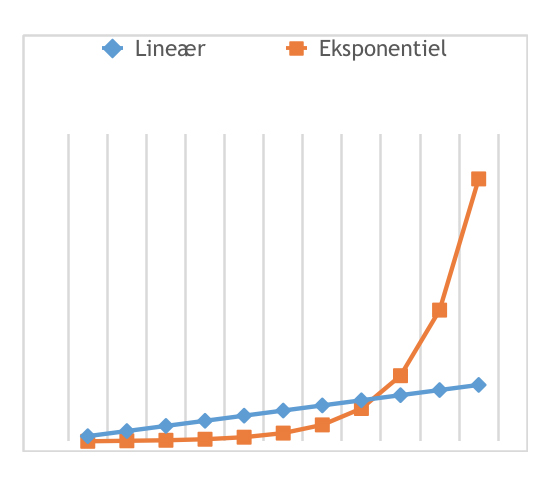
Exponential growth is often seen in biological systems. A colony of yeast cells, for example, where each cell divides in two every ten minutes grows exponentially with a growth rate of 100% every tenth minute. However, exponential growth is also found in the economy, where GDP may grow exponentially, and in the financial world where property prices can grow exponentially, which may eventually result in the bursting of a bubble.
In contrast to linear growth, the absolute amount with which an exponentially growing amount increases per time unit is not constant. If you have savings of 5,000,000 DKK at an interest rate of 5%, the savings will grow by 250,000 DKK in the first year, while in the next year, it will grow by 262,500 DKK, etc. This relationship makes exponential growth a tricky phenomenon because in the beginning, the growth seems to be harmless, but suddenly and very quickly it can explode. We can see this when we look at the phenomenon that some have called the great acceleration (see section 1), where a large number of factors, such as the global population and resource consumption, have grown exponentially and exploded in recent times. This growth has resulted in a lot of pressure and is threatening to destroy important global ecosystems.
An important concept in relation to exponential growth is doubling time, i.e. the time it takes for a certain amount of a particular unit to become twice as large. There are a number of stories that illustrate the surprising nature of doubling time in relation to exponential growth. For example, there is an ancient anecdote about the emperor of China, who wanted to reward the inventor of chess with a gift to say thank you for the amazing game. The inventor asked for a gift of rice. On the first square of the chessboard, the emperor was asked to put one grain of rice, on the second; two, on the third; four, on the fourth; eight, etc. On each new square, double the number of grains that were on the previous square. The emperor thought that this was a modest request, but he apparently was unaware of exponential growth because there was not enough rice in the whole of China to meet the inventor’s wish. Indeed, even before reaching the final square on the chessboard, the number of rice grains would exceed today’s total global rice production. And when reaching the final square, you would have to put down 263 grain of rice, which is a fantastically large number. It should be mentioned that the growth in each doubling time is greater than all the previous growth. Therefore, every time the amount doubles, more than the entire previous growth needs to be added.
Another example of doubling time comes from an old French riddle about water lilies, which illustrates how suddenly something can grow. The riddle is as follows: You own a small lake on which there grows a water lily. Every day, the area of the lake’s surface that the plant covers with its floating leaves doubles. If you do not keep the water lily’s growth in check, it will cover the entire lake in 30 days. If this happens, not enough sunlight will reach the lake, which will be catastrophic for the other species living in the lake. For many days, the water lily does not cover much of the lake, so you do nothing to limit its growth. In fact, you decide that you will only do something about it when it covers half of the lake’s surface. The question is – on which day will that be? The answer is day number 29; that is the day before it covers the entire lake, which means that you only have one day to do something about the problem. The morale of this riddle is that exponential growth may seem unproblematic and manageable, but it suddenly becomes too late to do anything about the problem.
One of the factors that make our present time so complicated is that it is characterised by interlinking exponential growth with regards to several variables: consumption of resources, pollution, global population, house prices, etc. As we have tried to illustrate, exponential growth is a tricky phenomenon which makes it very difficult to discern the change in these interlinking variables and systems.
Overview of the doubling times of different growth rates. There is a rule of thumb for estimating the doubling time of exponential growth. You simply divide the number 70 by the growth rate. Example: Growth rate = 5%. 70/5 = 14.
Next: Production result – the ’real cake’
